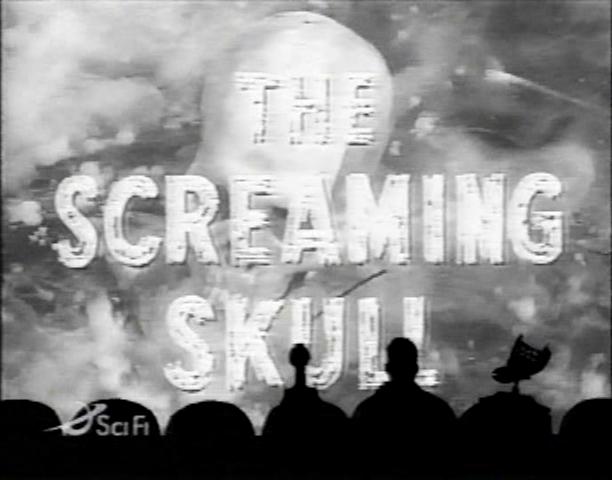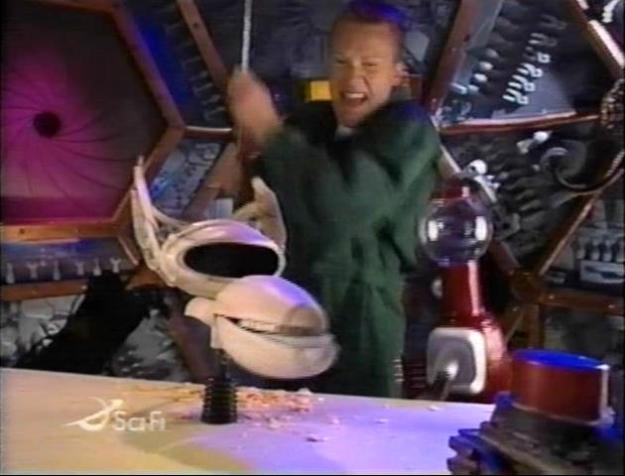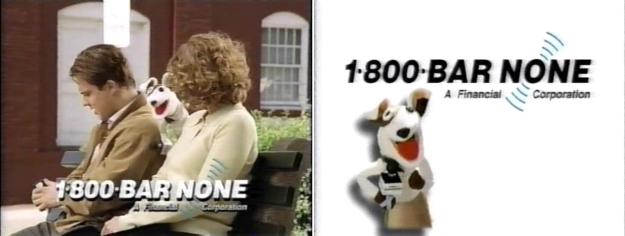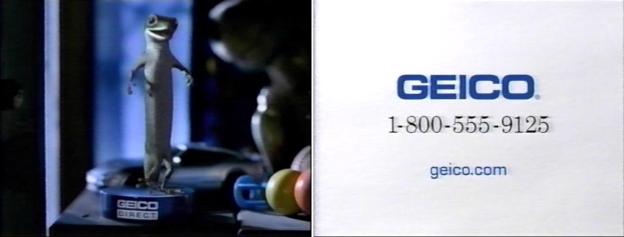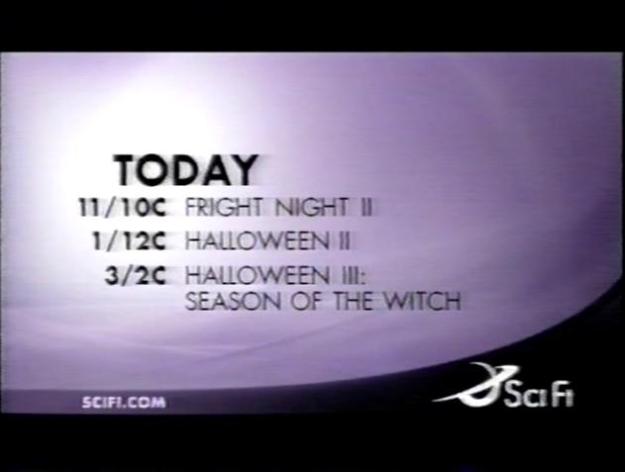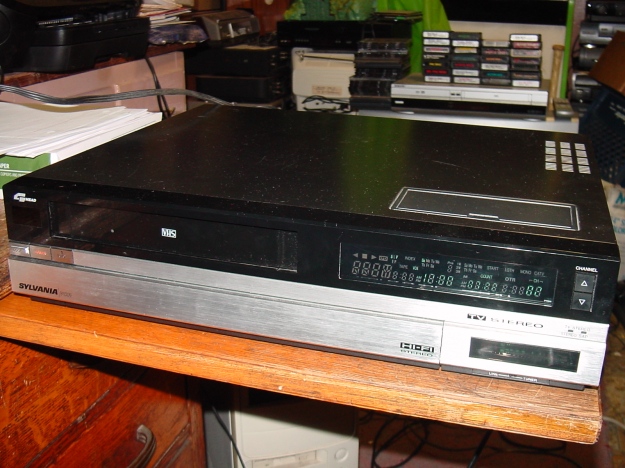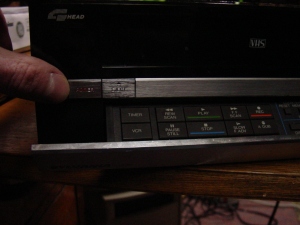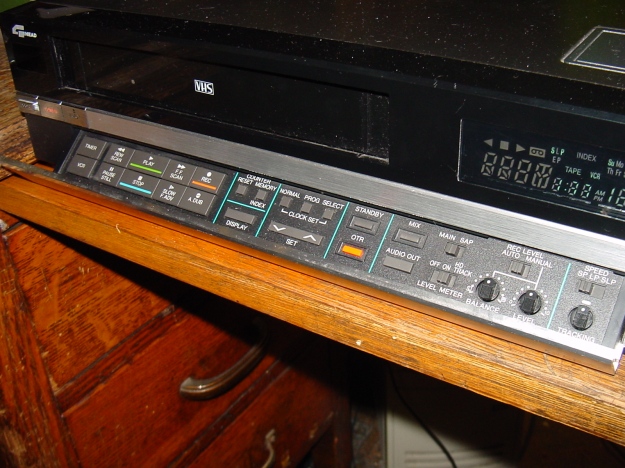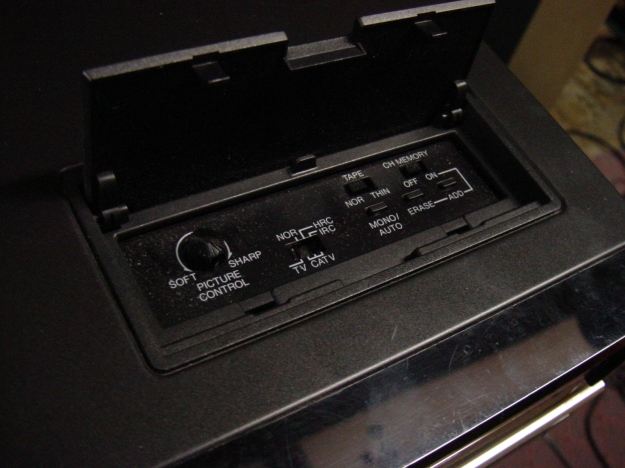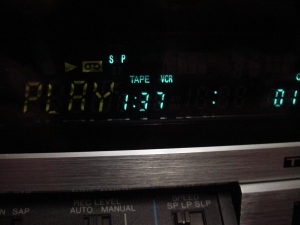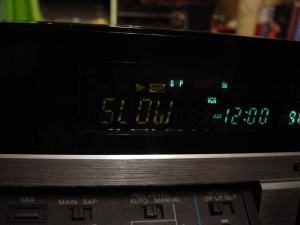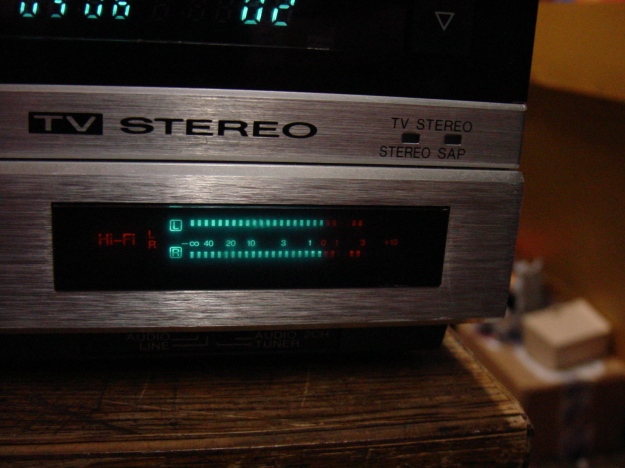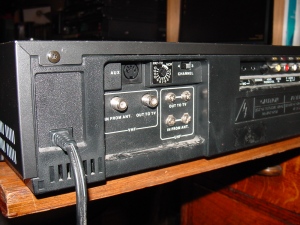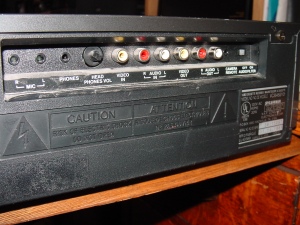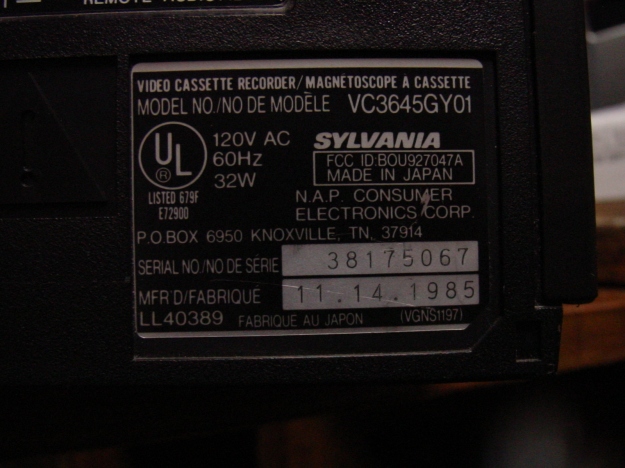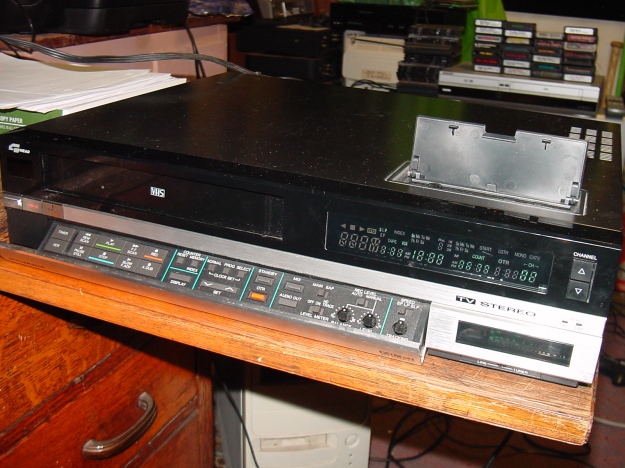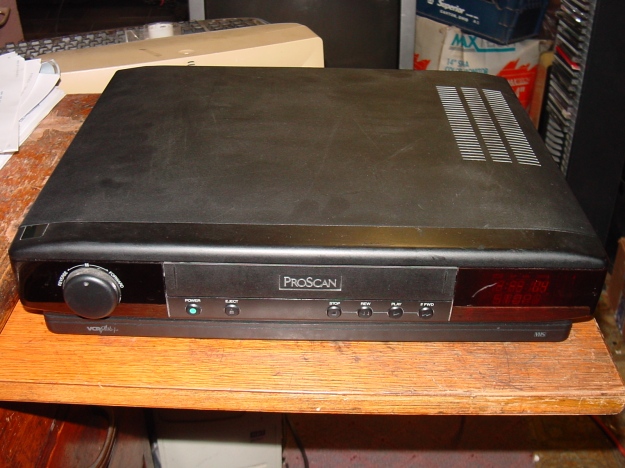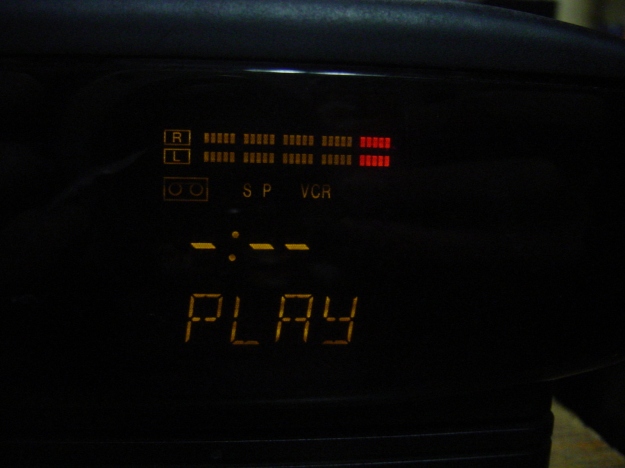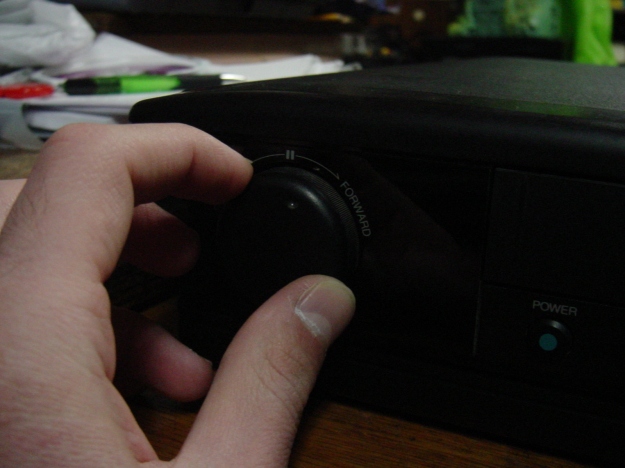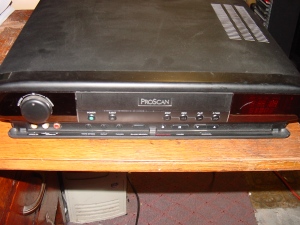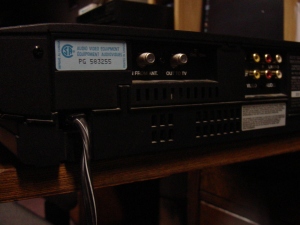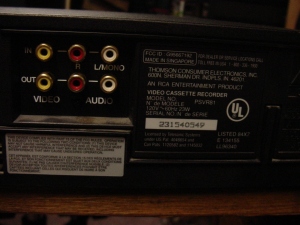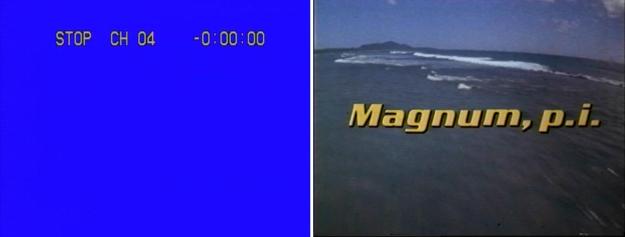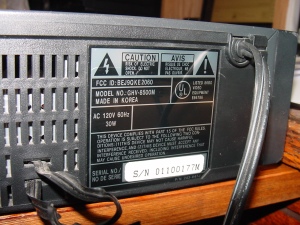
Happy Thanksgiving!
We are now at quite possibly my favorite point in the whole year: right smack in the middle of the holiday season. The three-pack of Halloween-Thanksgiving-Christmas is the genesis of some of my fondest memories, and every year I look forward to this three-month stretch.
When it comes to Thanksgiving, not only do you have the excitement of Halloween just behind you and the anticipation of Christmas literally right around the corner, but you have a holiday that really gets by on just its own merits; all you have to do is eat and be thankful. That’s it! The absence of the crass, mega-commercialization that has come to define Christmas is something I really like about Thanksgiving (early bird sales on turkey day notwithstanding), though Christmas has the deeper symbolic meaning (at least, it’s supposed to). But then, both of those holidays can entail visiting with relatives you may or may not be able to stand, in which case Halloween gains the upper-hand in the “mental well-being” department. (Ironic, huh!)
In all seriousness, I really do love all three. Why am I not including New Years in that lot? Meh, New Years has always been kind of a downer to me. I see it as heralding the end of the holiday season I have just enjoyed so much, which of course is exactly what it is. Just doesn’t do it for me, man.
Anyway, Thanksgiving. It really is a simple concept (well, unless you’re the one hosting dinner), consisting mainly of eating copious amounts of food, being thankful, however one may personally go about doing that, and in more modern times, watching a whole lotta TV, which of course is the facet of the holiday that this post takes residence in. The annual Macy’s parade and football garner the most attention, but movies can be, and often are, a big, big part of it too.
In that regard, Thanksgiving’s unofficial movie mascot is none other than King Kong and his ilk. Maybe not so much anymore, but for years King Kong, Son of Kong and Mighty Joe Young were staples of Thanksgiving Day television broadcasts in markets all across the country. Indeed, a few years back we took a look at a complete 1979 broadcast of Son of Kong on New York’s WOR-9, and this year, we’re going to see Papa Kong himself in action.
For Thanksgiving this time around though, we’re not going to look at Kong via an old television broadcast, but rather through, quite possibly, the first home video release of the original 1933 film. From 1978, here is King Kong on The Nostalgia Merchant label, and from top-to-bottom, it’s one of the coolest tapes in my collection (I don’t make that statement lightly, either!).
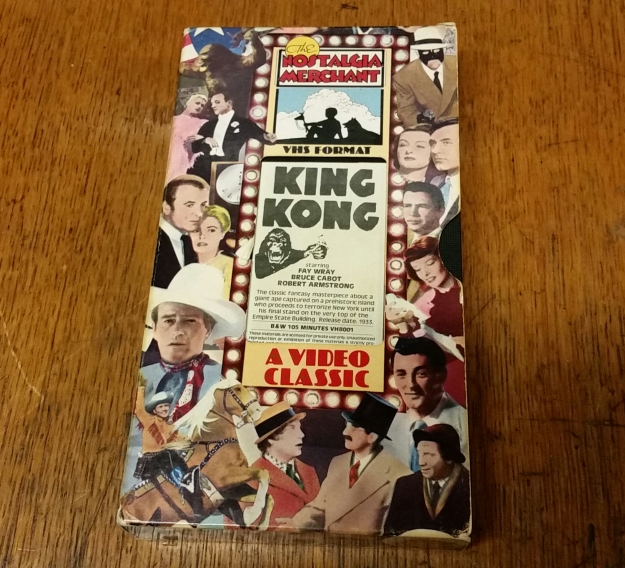
This is not an easy tape to come across. In fact, it’s pretty darn rare. So when I saw a copy for sale online (the first one I had ever seen, actually) and fairly-reasonably priced to boot, I jumped at it. Money well, well spent, and that’s coming from me, a guy that’s almost perpetually broke!
Yeah, yeah, I can hear it now: “Well, gee, Northeast Ohio Video Hunter, I’m seeing a buncha Nostalgia Merchant Kong tapes for sale online!” Okay, finding the movie on the Nostalgia Merchant label itself isn’t even remotely hard; beginning around the mid-1980s, Nostalgia Merchant had a wide range of films out on video store shelves, complete with pretty cool, eye-catching slipcases. Heck, I’ve had that respective VHS release of King Kong for years now.
This tape, however, isn’t one of those. This is from before all that. From how I understand it, and I’m the first to admit I’m no expert here, Nostalgia Merchant first began life in 1976, at the dawn of the home video era as we now know it. They first specialized in 16mm and Super 8 films and the like, and then, near as I can tell, began releasing their movies on VHS and Betamax starting in 1978. Considering pre-recorded home videos didn’t come on the scene until 1977, Nostalgia Merchant was in the game waaay early on. I have no idea if these were mail-order only releases or how long they were available before the more well-known iteration of the company (apparently after it affiliated with Media Home Video) began re-releasing many of the same movies in their subsequently more-common form, but I do know that these 1978-copyrighted tapes are (at the very least) highly obscure nowadays.
Indeed, I had no knowledge of these super-early Nostalgia Merchant releases at all until I happened upon one at a nearby thrift store some months back. It was volume 3 in Nostalgia Merchant’s line of Laurel & Hardy shorts releases, which was cool enough on its own, but it was the copyright of 1978 that figuratively raised my eyebrows; in this day and age, I really don’t come across tapes of such vintage all that often. When I do, I tend to snap them up, so in the case of Laurel & Hardy, I had no problem plunking down my three big bucks.
Still, for as much as I like Stan & Ollie, which is quite a bit, when I looked at that generic die-cut sleeve emblazoned with all the stars ostensibly available on the label, and especially at the list of other titles available on the back, I couldn’t help but feel that getting some of them in the ‘format’ would be even cooler. Make no mistake, King Kong was way, way at the top of that list. So again, when I happened upon a copy for sale online, I had to take the plunge.

Now that I’ve got my precious, precious King Kong, I’m seeing several more “gotta haves” listed on the back of the box. In the same vein as the subject for today, Mighty Joe Young is probably now at the top of that list. Furthermore, apparently the only legitimate video release of Return of the Ape Man was on an early Nostalgia Merchant tape like this, so needless to say that’s also something I need in my life, as well.
Believe it or not, I had to order this movie from a Canadian seller, but as the sticker on the back of the box attests, it originally hails from Chi-Town. Whether the tape eventually arrived in Canada due to something such as the owner simply moving there, or instead due to a more convoluted history, I couldn’t say. No matter, it’s in my hands now, and that’s where it’s going to stay.
I find the old video store sticker itself incredibly interesting, too. Since the national Hollywood Video chain was started in 1988, it’s a safe bet a tape this old wouldn’t be showing up at a Chicago chapter. Rather, methinks this was an early video store that happened to share the same name but was otherwise unrelated to said national chain. If someone had more info on this Hollywood Video, perhaps a more exact time-frame for the release this King Kong tape could be deduced (as in, how long it was, roughly, out there).
Anyway, some may see this old school video store sticker as a detriment to the original tape sleeve. Not me. I’m a sucker for remnants of the early video era, and this Hollywood Video of Chicago sticker fits that bill nicely. Besides, these generic early Nostalgia Merchant sleeves were all the same; someone could always switch it with another tape’s sleeve, should they wind up being overly concerned about this sort of thing.
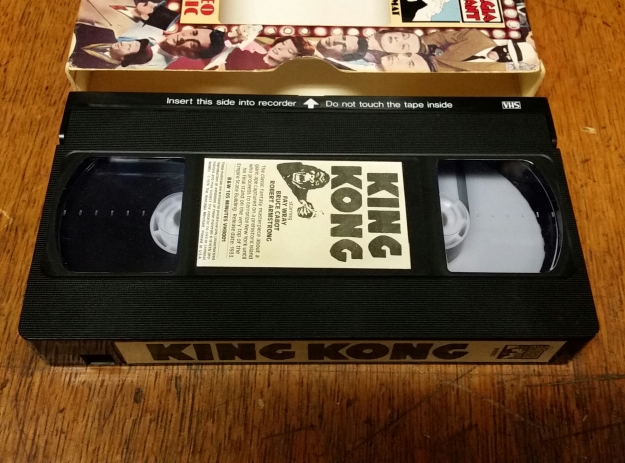
Like I said above, and just like my aforementioned Laurel & Hardy tape, this sleeve is a one-size-fits-all variety. In other words, it be generic. Anything pertaining to the movie contained within is on the tape label itself, rather than the back of the sleeve as would become common in short order. And actually, that’s not uncommon with these super-early video releases; for example, the very first pre-recorded videos on the Magnetic label eschewed any kind of description (beyond the basic facts of running time, stars, etc.) in favor of a list other titles available.
It wouldn’t take very long for that sort of thing to morph instead into a product that was really trying to sell the prospective buyer on the movie, both in fancy-shmancy artwork and descriptions so vivid they’d practically punch you in the face repeatedly until you decided to just rent the damn tape already. So, seeing these early examples of the format hold some interest beyond that whole initial “thas an old copyright!” exclamation you undoubtedly shrieked, either vocally or mentally.
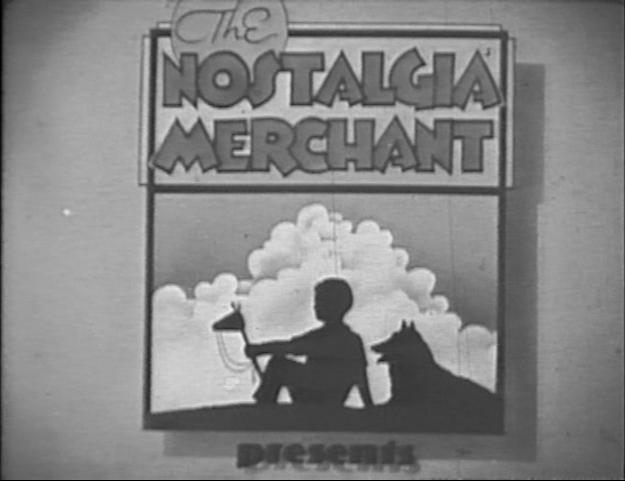
Also just like my Laurel & Hardy tape in the same format, the tape kicks off with a static, very “filmy” logo. I really have a hard time explaining it, it has a real home-made feel to it, like it was copied from an actual film reel or something. This site calls it a grainy, 16mm, Film-O-Vision style, and that explains it better than I ever could. See that up above? Thas the early Nostalgia Merchant logo, is what it is.

I love everything about this movie. Should I ever be required to absolutely, positively name my top 10 favorite films, this original King Kong is safely, safely on that list. It’s quite simply a film I’ve never gotten tired of.
You know, even though I own the movie many times over, old VHS releases are, to this day, still a severe weakness of mine. This one, I had to have it obviously, but really, any Kong tape I come across and don’t already own, it simply must become part of my collection. And therein lies a tale…
It all stems from when I first saw the 60th anniversary edition (with the swanky roaring chest box) for rent in 1996. I knew only the most basic details of Kong beforehand, but as soon as I laid eyes on that tape (and pressed that oh-so-cool roarin’ button), it became a film I had to see. It doesn’t hurt that I was just getting into horror and sci-fi films and general tape collecting around that time, either. I was with a friend and his mom at a kinda far-off video store when I saw that rental tape, so it couldn’t really come home with me right then, and besides, I wanted to own the film outright.
Problem was, the tape was released in 1993 (1933, 1993, 60 years, dig?), and in the three years since, for whatever reason, it was impossible to find for sale. Remember, this was before Amazon, eBay, and such. You were basically limited to the brick-and-mortar stores around town, and if Blockbuster couldn’t order it, guess what? Y’all was outta luck. (Oddly enough, I later did ask mom to call that store about the Kong tape, and they seemed to have no idea what we were talking about. The hell?)
So, being a young video taper, I banked on a TV airing. Even then I knew Kong was a Thanksgiving movie. But as luck would have it, it didn’t air that Thanksgiving. Figures. It didn’t really air anywhere at all, truth be told. So, I settled for whatever Kong did show up on TV. Before I was actually able to see the original, I recorded, watched, and became a Kong fanatic via the 1976 remake (which was, in retrospect, pretty bad, but I didn’t know any better at the time), the Japanese entries (King Kong Vs. Godzilla & King Kong Escapes), even the Son of Kong sequel I wound up seeing before I saw the movie that started it all.
Anyway, eventually Turner Classic Movies ran the original, I taped it, and here we are. But like I said before, to this day, when I come across a Kong tape, I pretty much need to buy it. Simply because it was so hard for me to see for so long. Doesn’t hurt that it’s a terrific movie that I appreciate more and more as the years go by.
That’s the title screen up above, by the way.

I can’t imagine anyone stumbling upon this post that hasn’t seen the original 1933 King Kong by this point. When it comes to classic giant monster movies, it’s pretty much the cream of the crop. From storyline to special effects to pure excitement, it’s incredible just how well this movie has held up. Some of the acting and attitudes date the film to the early-1930s, but those are easily forgotten thanks to the overall aura of timelessness that is the hallmark of genuinely great movies from the time period. Remember my similar sentiments regarding Undercurrent? They’re even more apt in regards to King Kong.
(Some spoilers ahead)
The plot concerns filmmaker Carl Denham (Robert Armstrong), famous for his many jungle movies, who wants to make the biggest and best jungle flick of them all. He needs a pretty face though. So, he heads out into New York to find the perfect girl for the part. He comes upon Ann Darrow (Fay Wray), who has some acting experience, albeit limited.
Ann is everything he’s been looking for. So, he enlists her for the picture, and he and his crew set off on the high seas, headed towards the mysterious “Skull Island.” The natives there supposedly worship a god they call “Kong,” an idea that hopefully promises to be the very spectacle Denham needs to make his film the massive success that he wants it to be.
When they finally arrive at the island, they stumble upon the native ceremony featuring their latest “bride of Kong.” The natives are initially angry at the interruption, until they notice Ann, and begin making offers for her (Denham: “Yeah, blondes are scarce around here.“). Denham and his crew obviously make a hasty retreat back to the boat.
That night though, the natives sneak aboard the ship and kidnap Ann. Her absence is quickly noticed, and the crew sets out to rescue her. When they arrive back on the island, they find that Ann is set as the new bride for Kong.
As per the screencap above, that’s when King Kong himself makes his grand entrance. Kong is a gigantic ape, the king of his domain, and he is instantly enamored with Ann. He grabs her and runs off into the jungle, leaving her would-be rescuers with little choice but to go into the unknown after her.

Kong ain’t the only big giant thing on Skull Island, though. Turns out numerous prehistoric creatures call the place home as well. Dinosaurs, pterodactyls, snakes, they’re all humongous and they all have to be dealt with along with Kong. Kong not only thwarts his pursuers, he’s also a scrapper; he fights (and defeats) every creature that comes his way, both to protect Ann as well as to further assert his dominance. This is Kong’s turf and he rules it completely.
The special effects here are largely of the stop-motion animation variety. Despite being from 1933, they, against all odds, hold up wonderfully today. Even with all the CGI trickery of modern movies (including Peter Jackson 2005’s version of King Kong, which was really far better than a remake has a right to be), stop-motion has such a, I don’t know, more natural look to it, I guess. It’s amazing how special effects from the early-1930s can still portray so well the emotions of the creature they’re animating. Somehow, you really believe Kong is excited, happy, angry or hurt. It’s uncanny!
Willis O’Brien was behind the stop-motion animation, and one viewing of King Kong is all it takes to know why he was such a master at his craft.

Ann is eventually rescued and Kong is captured and brought back to New York. A spectacle such as Kong is even better than the picture Denham intended on making!
For as great as the entire movie is, this is my favorite part of the film, when Kong escapes, re-captures Ann, and goes on a rampage throughout the city. The contrasts between the real jungle and the concrete jungle are obvious here, and just like on Skull Island, Kong is nearly unstoppable. He wages a path of destruction everywhere he goes, probably just as much out of fear and confusion as it is anger and protection of Ann.
For me, one of the most memorable parts of Kong’s trek through New York is his wrecking a passing train. The shots of the passengers unknowingly hurtling toward Kong and then the looks of shock and fear on their faces when he attacks drives home a point that may be hard (or even unfathomable) for some modern viewers to grasp: there was no instant communication back then! Kong could stomp around the city, surprise people in their apartments, even wreck a train, and no one would be the wiser until he’s upon them. No cell phones, no texts, no news update. I don’t know why this little aspect stands out to me, but it does.
The rampage through New York is actually fairly short, especially when compared to the amount of time spent on Skull Island, but it basically acts as the prototype for every “big huge monster causing havoc in a major city” film that was to follow. King Kong wasn’t quite the first movie to tackle this or other plot points featured in the film (1925’s The Lost World basically served as a test-run for much of this), but few, if any, films ever did it better.

And that all leads to one of the greatest moments in cinematic history: the climatic sequence of Kong climbing to the top of the Empire State Building and battling oncoming airplanes sent to shoot him down so Ann can be safely rescued.
I think we all know how it ends: Kong puts up a valiant effort, but in the end, the bullets take their toll and Kong tumbles off the building to his death. And yet, even though the ending is common knowledge nowadays, it still manages to be absolutely thrilling. And, despite the carnage, you actually feel for Kong here; you can actually see how he realizes he’s not going to win this fight, and you actually feel sympathy when he, in his own way, says goodbye to Ann before he gives up the ghost. The whole sequence is just fantastic.
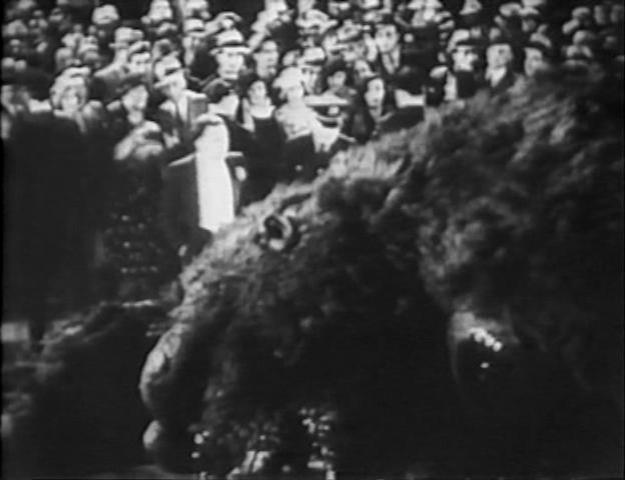
And that ending scene! Even if you’re just limiting yourself to giant monster movies, it’s hard to top it: after Kong has met his demise, Denham pushes his way through the crowd and looks sadly at the creature. His response to the statement that the planes got him? “It wasn’t the airplanes, it was beauty killed the beast,” one of the great final lines in movie history. That coupled with that last image and then the fade-out, man, it’s just fantastic.
Yeah, I know, I just gave away much of the film, but even so, if you haven’t seen this movie, go see it! I can’t possibly do it the justice it deserves in just this article alone.
A couple points about this particular release of King Kong:
First off, it’s pretty scratchy and dirty. Some scenes are way too bright, and some scenes are way too dark. It looks more like an old television print than it does a home video release; heck, this might be an old television print, though it’s missing the identifying hallmarks of such (i.e. the old “C&C Movietime” logo that vintage TV prints often carried). Most people probably didn’t care at the time though; it was such a novel concept to be able to own and watch a movie at home whenever you wanted that the print quality of the movie wasn’t that much an issue. Still, it’s probably safe to say that this is the roughest looking print of Kong ever released to home video proper (excluding pre-VHS/Beta releases, of course).
Also, the label states the run time is 105 minutes; Ignore that. The running time is closer to 97 minutes. Yes, this is an older, cut print of King Kong!
Lemme explain: when Kong was first released in 1933, it was a Pre-Code film. That is, it was released before the infamous Hays Code was rigidly enforced. But, the film was so monumentally popular that it was re-released numerous times throughout the years when the Hays Code was rigidly enforced. Thus, scenes that passed muster the first time around were steadily excised for subsequent releases. Segments featuring Kong ripping off Wray’s clothes and sniffing his fingers, stomping and chewing on natives, and dropping a woman to her death during his New York rampage were all deemed inappropriate and eventually edited out of the movie.
Those scenes were later rediscovered and added back to the film, and most home video releases (to the best of my knowledge) are of the complete King Kong…but not this one. That’s right, many (or even all) of those ‘controversial’ segments are missing from this early Nostalgia Merchant release! Whether this is a result of this being an old print prepared for TV or just a pre-restored print in general, it’s still pretty surprising to see this cut version of the movie, especially since every home video version I had seen prior had all of the footage. Even the later Nostalgia Merchant releases specifically touted the film as the uncut version.
I’m not complaining though. In this and age, it’s nearly impossible to find a version of the film that isn’t complete. But to watch one of the older variations, one that several generations of movie lovers probably grew up with, and in its probable initial home video release, no less? That’s pretty cool!
By the way, the long-lost spider pit sequence isn’t in this one, either.

It’s tough for me to find words adequate enough to portray just how cool this tape is. Sure, at heart, it’s just an old, scratchy, edited print of King Kong. It wouldn’t be the choice of purists, I know.
But that’s not really the point. This was, in all likelihood, the first release on the then-fledgling VHS home video format. It’s not even just that this was probably the first, either; rather, it’s what that represents (and this goes for the early years of home video in general). That is, no longer would someone have to wait for their favorite film to show up on TV, which in the case of King Kong, could conceivably not be until next Thanksgiving. With a tape like this, any day could be Thanksgiving.
And that’s yet another reason why I do what I do and collect what I collect. It goes beyond the movie, beyond the copyright date, and deeper into what it all represents as a whole. Man I love this hobby.
Plus, it is a really, really old release of King Kong. I can analyze all day if need be, but when it comes right down to it, that’s just neat. No way could I have envisioned owning this when I first set my eyes upon that roaring box edition way back in 1996!
Have a great Thanksgiving, everybody!
 Dig this intensely cool piece of 1990s home video technology I picked up! Found recently (at the end of January or start of February) at a somewhat-far-off thrift store, the RCA “Home Theatre” S-VHS VCR (model number VR725HF) came into my life…for only $4. Four bucks?! That’s a great price for a regular VHS VCR, never mind an S-VHS VCR! Needless to say, it became mine.
Dig this intensely cool piece of 1990s home video technology I picked up! Found recently (at the end of January or start of February) at a somewhat-far-off thrift store, the RCA “Home Theatre” S-VHS VCR (model number VR725HF) came into my life…for only $4. Four bucks?! That’s a great price for a regular VHS VCR, never mind an S-VHS VCR! Needless to say, it became mine. hey, maybe there was more that could be accessed there. As it stands here though, you’ve got only standard play-stop-eject-rewind-forward-record-pause options at your fingertips. I can’t even access the much-ballyhooed VCR Plus+ option. Near as I can tell, anyway.
hey, maybe there was more that could be accessed there. As it stands here though, you’ve got only standard play-stop-eject-rewind-forward-record-pause options at your fingertips. I can’t even access the much-ballyhooed VCR Plus+ option. Near as I can tell, anyway. Speaking of recording, you didn’t have to record in S-VHS; you could use this as a regular ol’ VHS VCR, if you so desired. This is accessed through the little S-VHS button pictured here. The light sez it’s on. Since S-VHS required specific S-VHS tapes, and since regular VHS tapes were far more common, if you wanted to pick up a cheap blank tape at the grocery store, you’d just push the S-VHS button “off,” and then you were good to go! I don’t know if the recording quality for normal VHS would have been any better than usual, but 4-Head Hi-Fi is always a good thing anyway.
Speaking of recording, you didn’t have to record in S-VHS; you could use this as a regular ol’ VHS VCR, if you so desired. This is accessed through the little S-VHS button pictured here. The light sez it’s on. Since S-VHS required specific S-VHS tapes, and since regular VHS tapes were far more common, if you wanted to pick up a cheap blank tape at the grocery store, you’d just push the S-VHS button “off,” and then you were good to go! I don’t know if the recording quality for normal VHS would have been any better than usual, but 4-Head Hi-Fi is always a good thing anyway. housed in good ol’ metal, and with the black color-scheme, it’s a pretty slick-lookin’ beast. There’s some rounding on the front corners, but it’s mostly slim and boxy, though ridges (?) along the bottom almost give it a foot-stand-like appearance. I don’t know how to describe this, bu I tried to show you in the pic here.
housed in good ol’ metal, and with the black color-scheme, it’s a pretty slick-lookin’ beast. There’s some rounding on the front corners, but it’s mostly slim and boxy, though ridges (?) along the bottom almost give it a foot-stand-like appearance. I don’t know how to describe this, bu I tried to show you in the pic here. them, and came up with the 2003 CBS broadcast of Bruce Springsteen’s Barcelona concert. I’ve owned the entire show on DVD for years, but this was recorded in S-VHS SP, so hey, gotta check it out!
them, and came up with the 2003 CBS broadcast of Bruce Springsteen’s Barcelona concert. I’ve owned the entire show on DVD for years, but this was recorded in S-VHS SP, so hey, gotta check it out!










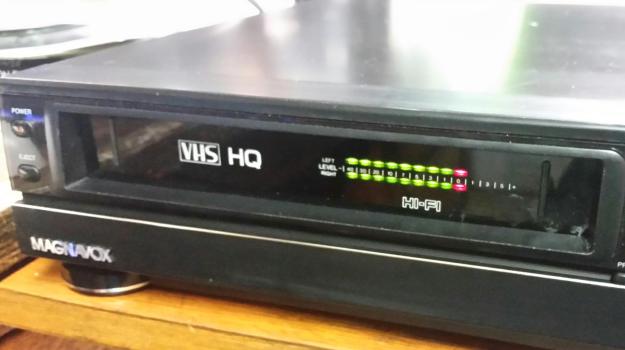



 Upon firing the sucker up, you’re presented with the previously-mentioned blue-screen.
Upon firing the sucker up, you’re presented with the previously-mentioned blue-screen.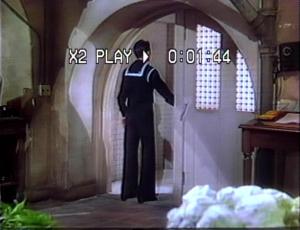 this VCR if needed, but it was showing its age. Some tracking issues, a little jittery, nothing major but still not preferable.
this VCR if needed, but it was showing its age. Some tracking issues, a little jittery, nothing major but still not preferable. Here’s the remote. It’s always nice when one of those are included, though in this case, the only function on it that I’m not seeing on the VCR itself is a button labeled “calendar.” For all I know, that function is accessed through some other way on the unit.
Here’s the remote. It’s always nice when one of those are included, though in this case, the only function on it that I’m not seeing on the VCR itself is a button labeled “calendar.” For all I know, that function is accessed through some other way on the unit. inputs and outputs and whatnot that, quite frankly, I don’t always know the purpose of. I’m not sure how I feel about this; simplicity is nice, but so is having option upon option.
inputs and outputs and whatnot that, quite frankly, I don’t always know the purpose of. I’m not sure how I feel about this; simplicity is nice, but so is having option upon option. Here are the inputs, such as they are, on the back of the VCR. There’s not much to talk about here; you’ve got red-white-yellow inputs and outputs, as should be expected, a channel selector, and antenna inputs and outputs.
Here are the inputs, such as they are, on the back of the VCR. There’s not much to talk about here; you’ve got red-white-yellow inputs and outputs, as should be expected, a channel selector, and antenna inputs and outputs.
 You know, I originally had a whole different post planned for a late-July update. It didn’t happen, with the result being that now I’m scrambling to get something up before the end of the month, lest the blog become, uh, update-less. Or something like that.
You know, I originally had a whole different post planned for a late-July update. It didn’t happen, with the result being that now I’m scrambling to get something up before the end of the month, lest the blog become, uh, update-less. Or something like that. was some trailer for The Mask of Zorro, but the main areas of interest for our purposes today are the two Godzilla-related bits.
was some trailer for The Mask of Zorro, but the main areas of interest for our purposes today are the two Godzilla-related bits. So, Godzilla, the movie itself. That’s the title screen to the left, yo. As I said, I didn’t see it in theaters during release, though I was certainly excited for it. The Taco Bell tie-in promotion was sampled, and toys were collected. Even better, the wave of promotion brought forth reissues of many of the original Godzilla movies on VHS, some of which had become pretty hard to find prior. I think only Godzilla Raids Again and Godzilla vs. the Smog Monster remained MIA, though Destroy all Monsters got a first-ever US video release around that time, as did many of the heretofore unavailable (domestically) installments from the 1990s. It was great, and I fondly recall going to Blockbuster one night, seeing 1991’s Godzilla vs. King Ghidorah on the shelves along with a slew of other new-to-me entries, and just being blown away. This was completely unfamiliar territory to me!
So, Godzilla, the movie itself. That’s the title screen to the left, yo. As I said, I didn’t see it in theaters during release, though I was certainly excited for it. The Taco Bell tie-in promotion was sampled, and toys were collected. Even better, the wave of promotion brought forth reissues of many of the original Godzilla movies on VHS, some of which had become pretty hard to find prior. I think only Godzilla Raids Again and Godzilla vs. the Smog Monster remained MIA, though Destroy all Monsters got a first-ever US video release around that time, as did many of the heretofore unavailable (domestically) installments from the 1990s. It was great, and I fondly recall going to Blockbuster one night, seeing 1991’s Godzilla vs. King Ghidorah on the shelves along with a slew of other new-to-me entries, and just being blown away. This was completely unfamiliar territory to me! forget that the format can look and sound really, really nice. Relatively speaking, of course; it’s still not digital quality, but as a product of a major studio, this widescreen version of Godzilla could (and probably did) show off entertainment centers equipped only with VHS pretty adequately. Also, an SP recording never hurts.
forget that the format can look and sound really, really nice. Relatively speaking, of course; it’s still not digital quality, but as a product of a major studio, this widescreen version of Godzilla could (and probably did) show off entertainment centers equipped only with VHS pretty adequately. Also, an SP recording never hurts.























